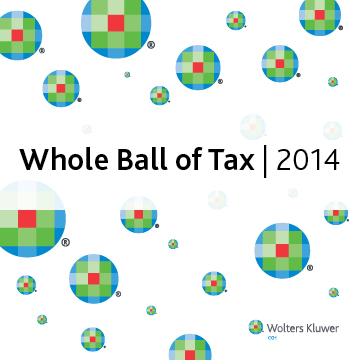 |

Wolters Kluwer, CCH can assist you with stories, including interviews with subject experts.
Also, the 2014 Whole Ball of Tax is available in print. Please
contact:
Eric Scott
(847) 267-2179
eric.scott@wolterskluwer.com
Brenda Au
(847) 267-2046
brenda.au@wolterskluwer.com
Visit the Whole Ball of Tax site often as new releases and other updates will be posted
throughout the tax season.
Wolters Kluwer, CCH provides special CCH Tax Briefings on key topics at: CCHGroup.com/Legislation.
|  |
2014 CCH Whole Ball of Tax
Retirement By the Numbers: Employer Plans, IRAs and the Saver's Credit
Saving Opportunities Remain the Same Across Retirement Plans for 2014
Both IRA contribution levels and contribution limits to employer-sponsored programs are subject to cost of living adjustments (COLAs), which did not increase for 2014. As a result, the contribution levels for IRAs, 401(k)s and employer-sponsored programs remained the same from 2013 to 2014.
The allowable adjusted gross income (AGI) parameters for IRAs, however, did increase for 2014. Income thresholds for 2014 also increased under the Retirement Savings Contributions Credit, commonly known as the Saver’s Credit, which is a nonrefundable tax credit that allows lower- and middle-income retirement plan participants to use elective contributions to reduce their federal income tax on a dollar-for-dollar basis.
Employer-sponsored Programs |
Retirement Vehicle |
Maximum 2014
Employee Contribution* |
Catch-up Contributions |
401(k), 457 and 403(b) plans |
$17,500 – pre-tax dollars
(same as 2013) |
$5,500
(same for 2013) |
Roth 401(k), 403(b), and 457 plans |
$17,500 – after-tax dollars
(same as 2013) |
$5,500
(same for 2013) |
SIMPLE plans |
$12,000 – pre-tax dollars
(same as 2013) |
$2,500
(same for 2013) |
SARSEP**
(Salary Reduction SEP) |
$17,500 – pre-tax dollars
(same as 2013) |
$5,500
(same for 2013) |
IRAs*** |
Retirement
Vehicle |
2014 Maximum Contribution Limits* |
Catch-up Contributions |
Adjusted Gross
Income (AGI) Restrictions |
Traditional Deductible IRA |
$5,500
(same as 2013) |
$1,000
(same for 2013) |
For active participants in employer provided plan:
Single filers: under $60,000 phasing out completely at $70,000 ($59,000 phasing out completely at $69,000 for 2013)
Married, filing jointly: under $96,000 phasing out completely at $116,000 (under $95,000 phasing out completely at $115,000 for 2013) |
Traditional Nondeductible IRA |
$5,500
(same as 2013) |
$1,000
(same for 2013) |
N/A |
Roth IRA Nondeductible |
$5,500
(same as 2013) |
$1,000
(same for 2013) |
Single filers: under $114,000 phasing out completely at $129,000 (under $112,000 phasing out completely at $127,000 for 2013)
Married, filing jointly: under $180,000 phasing out completely at $190,000 (under $178,000 phasing out completely at $188,000 for 2013) |
* Subject to COLAs.
** SARSEPs must have been established prior to January 1, 1997. The maximum contribution and catch-up amounts are the same as for 401(k), 457 and 403(b) plans.
*** Individuals have until April 15, 2014, to make contributions to their IRAs for 2013.
Retirement Savings Contributions Credit**** |
Retirement
Vehicle |
2014 Maximum Credit |
Adjusted Gross
Income (AGI) Restrictions |
IRAs, Roth IRAs, SIMPLE Plans, 401(k)s and other qualified retirement plans |
$1,000 for single filers
$2,000 for joint filers |
Single filers: $30,000 or less ($29,500 for 2013)
Head of household filers: $45,000 or less ($44,250 for 2013)
Married, filing jointly: $60,000 or less ($59,000 for 2013) |
**** Depending on AGI, the Retirement Savings Contribution Credit, commonly referred to as the Saver’s Credit, provides a credit ranging from 10% to 50% with lower income taxpayers being eligible for a higher credit. For example, a married taxpayer filing jointly with an AGI of less than $36,000 making a $2,000 retirement plan contribution in 2014 could be eligible for a 50% credit, or $1,000. By contrast, if that same taxpayer had an AGI between $36,000 and $38,999, would be eligible for a 20% credit, or $400; an AGI between $39,000 and $59,999 would make that same taxpayer eligible for a 10% credit, or $200.
SOURCE: Wolters Kluwer, CCH: 2014
Permission for use granted.
nb-14-12
|
|
|
|
